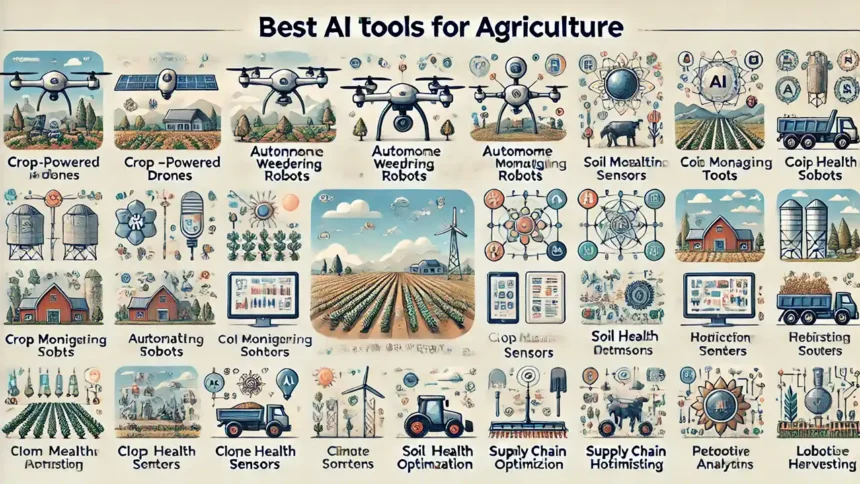Boosting Farm Productivity: The Best AI Tools for Agriculture in 2024
In 2024, artificial intelligence (AI) continues to be a game-changer in agriculture, offering innovative tools that enhance productivity, precision, and sustainability. With rising challenges such as labor shortages, climate change, and the need for higher crop yields, AI tools empower farmers to make informed decisions, optimize resources, and improve efficiency. Let’s explore the top 10 Best AI Tools for Agriculture that are transforming agriculture in 2024.
Top 10 Best AI Tools for Agriculture
1. Precision Agriculture Drones
AI-powered drones have transformed farm management by allowing high-precision aerial views of fields. Equipped with sensors and cameras, drones monitor crop health, moisture levels, and detect issues like disease and pest infestation. AI algorithms then analyze this data, enabling targeted interventions that reduce pesticide usage and improve crop health. Companies like Precision AI use machine learning for weed detection and other crop-specific actions, reducing the need for herbicides.
2. Autonomous Weeding Robots
Autonomous robots like those from EcoRobotix and Naio Technologies can identify weeds and remove them without chemicals, addressing the need for sustainable farming. These robots utilize AI for plant recognition and movement, helping farmers manage weeds with precision and less environmental impact. Such technology is expected to increase yield and reduce costs by focusing on targeted weed removal.
3. AI-Powered Crop Monitoring Tools
Crop monitoring tools powered by AI, like Taranis, provide real-time updates on crop health. Using image recognition and big data analysis, these tools help detect issues early and suggest corrective actions. This predictive approach improves crop quality, minimizes waste, and ensures better yield. Advanced sensors gather data on soil nutrients, moisture levels, and crop conditions, helping farmers make timely interventions.
4. Farm Management Software
Farm management software such as Bushel Farm consolidates essential farming tasks, from inventory to finances, into one interface. With AI-driven insights, these platforms suggest optimal planting times, manage resources efficiently, and predict market trends. This software integrates with devices on the farm, making operations smoother and more profitable by providing actionable insights and reducing the burden of manual tracking.
5. AI-Based Climate Prediction Models
Agriculture is heavily affected by climate variability, making accurate predictions crucial. AI-based climate prediction models analyze historical data and current climate patterns to predict weather and its impact on agriculture. Companies like ClimateAI provide insights that help farmers adjust planting schedules and resource management to minimize risks from unpredictable weather. By aligning farming practices with these forecasts, farmers can safeguard crops and enhance resilience against climate change.
6. Soil Health Monitoring Sensors
AI-powered soil sensors, like those developed by CropX, analyze soil composition, pH levels, and moisture. These sensors feed data into AI algorithms, which recommend fertilizer and water adjustments for optimal crop growth. This precision agriculture technique maximizes nutrient efficiency, conserves water, and reduces environmental impact. Accurate soil management translates into healthier crops and improved yields.
7. Livestock Health Management Tools
AI tools in livestock farming, such as Cainthus and CattleEye, monitor animal behavior, health, and diet. Using image recognition and data analysis, these tools detect early signs of illness and nutritional deficiencies. With real-time data, farmers can make quick adjustments, improving animal welfare and farm productivity. The automation of livestock monitoring helps farmers manage large herds more effectively with reduced labor costs.
8. Supply Chain Optimization Tools
AI enhances supply chain efficiency by forecasting demand, optimizing storage, and minimizing wastage. Tools like Helios AI offer real-time insights into supply chain disruptions, helping agricultural businesses make timely adjustments. Predictive analytics ensures products reach the market in peak condition, reducing spoilage and supporting sustainable practices. These tools aid in delivering fresh produce by ensuring accurate demand predictions and supply chain resilience.
9. Agricultural Robotics for Harvesting
Robotic harvesters, like those developed by FFRobotics, are equipped with AI to identify and pick fruits without damaging them. These machines are particularly useful for labor-intensive crops like strawberries and apples. AI algorithms enable robots to detect ripeness, ensuring high-quality harvests. With labor shortages being a concern, these robotic solutions provide efficient alternatives to manual picking and help farmers save on labor costs.
10. Predictive Analytics for Crop Yield Forecasting
AI-driven predictive analytics tools forecast crop yields by analyzing historical data, weather patterns, and market trends. Tools such as Agribotix help farmers make data-informed decisions regarding crop selection and planting schedules. This approach enables precise planning, helping farmers anticipate demand and align supply accordingly. Predictive analytics also supports food security by optimizing harvests and resource usage.
Conclusion
AI has become a pivotal asset in agriculture, addressing many of the industry’s most pressing challenges. From predictive analytics to autonomous robots, these AI tools are not only increasing efficiency and productivity but also promoting sustainable practices. As we continue to face environmental and economic pressures, AI-driven agriculture promises a future where food production can meet global demand responsibly and effectively. Embracing these AI Agricultural Tools will be essential for farmers looking to thrive in 2024 and beyond.
FAQs
How does AI help in crop monitoring?
AI in crop monitoring uses sensors and cameras to analyze plant health, detect diseases, and identify pest infestations, helping farmers intervene early.
Are AI-powered drones beneficial for small farms?
Yes, AI-powered drones are useful for farms of all sizes as they provide cost-effective solutions for monitoring large areas and optimizing crop health.
What are some examples of AI tools in livestock management?
Examples include CattleEye and Cainthus, which monitor livestock health, detect illness, and optimize feeding patterns using image recognition and data analysis.
How does predictive analytics benefit farmers?
Predictive analytics helps farmers forecast crop yields, optimize planting schedules, and anticipate market demand, making farming operations more efficient and profitable.
Can AI tools improve the sustainability of agriculture?
Yes, AI tools help farmers reduce resource use, lower environmental impact, and adopt sustainable practices by optimizing inputs like water and fertilizer.





